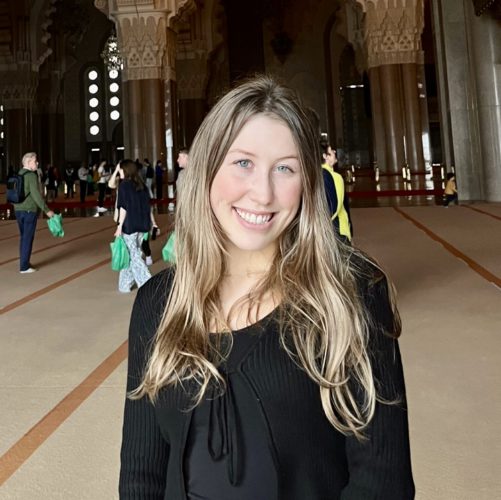It’s all about balance

caption
Photo illustration by Ella Macdonald.Ukraine or Pakistan? Taking steps toward equal global coverage
It’s the early ’90s in Papua New Guinea and the AIDS epidemic is decimating entire populations in the global south. U.S. and Canadian media primarily opt to cover the epidemic’s impact on countries north of the equator.
Rachel Pulfer is in her early teens and her family has just moved to this small Oceanic country from sub-Saharan Africa. She goes to school, surrounded by classmates and teachers who are terrified of this mysterious plague that — according to the press — is a northern problem.
“HIV was far more destructive than it could have been, had there been more resources devoted to covering its impact in global south countries,” says Pulfer, now executive director of Journalists for Human Rights (JHR) in Toronto.
A 2001 UNAIDS/WHO report stated 40 million people were living with this disease worldwide – 28.5 million in sub-Saharan Africa. But Africa-related stories only made up 3.1 per cent of America’s AIDS coverage in 1993.
Papua New Guinea had roughly 24,000 AIDS-related deaths since it was first identified in the country in 1987, according to a 2016 Lancet report.
In 1992, The Globe and Mail’s coverage included the epidemic’s spread across Canada, new potential treatments and how political stances on AIDS were affecting the U.S. presidential election.
But ‘objectivity’ …
Mainstream newsrooms still aren’t reporting on global affairs with a balanced approach, and justify it with news values.
In February 2022, Russia invaded Ukraine, setting in motion a war that would displace 13 million people, dominating headlines for months to come. Then in June, Pakistan suffered devastating floods that plunged one-third of the country underwater.
Despite this natural catastrophe, South Asia has taken a backseat to Ukraine in North American coverage — internationally, nationally and locally.
“There’s very clearly an imbalance,” says Ahmar Khan, a Pakistani-Canadian digital broadcast journalist for Global News Toronto. “There are debates about if we should be covering, having segments or writing pieces on what’s going on in Pakistan, where 33 to 35 million people are displaced.”
This wasn’t the only obvious disparity in coverage this year. During the lead-up to Queen Elizabeth II’s funeral, the news was saturated with the same shot — a crowd waiting, Pulfer says. “Meanwhile, the planet is burning and sinking.”
There are 2.6 million South Asians in Canada, making up 7.1 per cent of the population, 2021 Census data finds, marking an increase of 647,000 people from 2016. In 2001, there were 917,000 South Asians in the country.
There’s clear demand for news stories affecting brown-skinned immigrant communities. Imbalance is pretty consistent in Canadian media, Khan says. Whether it’s Pakistan, Ethiopia’s Tigray people, or anything that happens in the global south, news values are used to rationalize rejected pitches and the Eurocentric news agenda.
Still, he finds what is underreported — from stories on Toronto shopkeepers fearing gentrification, to the concerns of Black and Indigenous voters during the 2021 federal election, and even the struggle of Black immigrants fleeing the war in Ukraine.
If reporters like Khan aren’t in a newsroom, legacy media will often dismiss the obligation to provide coverage and justify this gap by saying South Asians have ‘ethnic media’ to meet their needs. What they’re forgetting is Ukrainians do, too.
The amount of coverage a story receives should reflect its severity — which hasn’t been the case with Pakistan this year.
Calling the shots
Editors and producers decide what makes the news, not reporters.
Tracy Seeley is the director of newsgathering at CBC News and oversees all international deployments. Her job involves developing a strategy to prioritize stories, plus manage teams. She takes pitches from the assignment desks, which outline what the public interest is and why the story is important. These pitches may include deployment and budget requests or potential challenges.
Seeley takes this into account when deciding where to send her people, and over the past year, has frequently faced the decision of prioritizing Ukraine coverage over other world events. “It’s hard to overstate the stakes with that conflict,” Seeley says. “So it’s one that we feel committed to having an ongoing plan for coverage.”
Addressing the resulting gap in reporting on Pakistan, Seeley points to staff shortages as the reason for not deploying immediately. “I would say we could have done more coverage when it happened.”
This concern was raised internally at the CBC. Seeley says she’s aiming to remedy this with the opening of its India bureau in the new year. Plans were announced in October 2020.
Dashboards
Audience metrics are another factor the CBC considers. It uses Chartbeat, a data vendor that compiles analytics on news sites to show where public interest lies.
When the war in Ukraine began, Chartbeat recorded a 25 per cent increase in North American traffic across 4,540 media outlets worldwide, according to the International News Media Association.
But there’s danger in equating “what is quantifiable with what is valuable,” when consulting data, according to a 2015 Tow Report.
“Sometimes, something is just not on the audience radar,” Seeley says. “So we couldn’t make every decision that way, or there’s certain stories we’d never cover.”
Confronting bias
When looking at this year’s disparity in coverage between Ukraine and Pakistan, the question of skin colour is unavoidable.
Eurocentrism is common in North American media, Khan says. “Trying to get a story approved about Ukraine is a lot easier than, for example, getting a story approved about Pakistan or even India or China, just because of the relatability to some of our managers.”
It’s quantifiable. The 2021 Canadian Newsroom Diversity Survey finds 75 per cent of journalists identify as white across 209 newsrooms. In the U.S. and the U.K., white journalists are “significantly over-represented among top editors relative to their share of the general population,” the Reuters Institute stated in March 2022.
This dictates which communities the news serves, and how. The result is clear, whether unintentional or not: white journalists keep prioritizing white narratives. It makes accurate, fair and dedicated coverage of ‘other’ events — such as Pakistan’s floods — impossible.
In 2010, BBC listener Ulric Schollaert from Brussels complained about the placement of a Pakistan flooding story coming after the Chile mine rescue in a news bulletin, stating it was "close to insulting."
What about bias?
Charlie D’Agata was reporting from Kyiv for CBS News. He stated, on-air, the war was more unexpected than conflicts in Iraq and Afghanistan because Ukraine is “relatively civilized” and European. D'Agata apologized.
Dollar signs
Disparity in coverage is not an intentional exercise in racism and is rather suggestive of a financial gutting, Pulfer says. The industry has lost $4.9 billion over the last 12 years, according to Canadian Heritage, resulting in the closure of nearly 450 Canadian news outlets — 63 since the onset of COVID-19.
Funds determine capabilities, and journalists have to work within the constraints of available resources. Budget dictates the CBC’s ability to deploy newsgathering teams.
British journalist Liz Sly, the Washington Post’s correspondent-at-large for global affairs, views it differently. “All news is about taxation,” says Sly. “Basically, you have to be providing accountability for leaders and our governments and if we are paying taxes for something, we should be covering it.”
Hot takes
Shenaz Kermalli disrupts via op-eds. She’s a freelancer specializing in geopolitics and currently teaches journalism at Toronto Metropolitan University. She attributes disproportionate reporting to U.S.-centrism.
In 2021, Kermalli recognized a lack of coverage on the mounting death tolls in Palestine resulting from the Gaza-Israel conflict — so, she weighed in for the Toronto Star. “Op-eds are a great way to raise awareness about issues that wouldn't be on the news agenda,” Kermalli says. “And sometimes you write op-eds to pique people's interest and then you'll find it gets a lot of clicks.”
For international news coverage, Kermalli wants to see media companies hire local freelancers in the region they wish to report on. “Who better can understand an area, a neighbourhood, a country, a village — any place outside of Canada — better than the people who inhabit it?”
It’s an alternative to the longstanding practice of parachute journalism: sending reporters to cover regions or communities they’re unfamiliar with. North American news organizations keep sending journalists to do rapid-fire reporting.
At Journalists for Human Rights, Rachel Pulfer’s team is establishing programs in parts of the global south to support and strengthen local media.
In a way, Ukraine is a turning point, says Pulfer. The global south “is looking at all this money, resources, attention and concern being poured into Ukraine when you know, the exact same thing was happening in Syria not three years ago,” Pulfer says, “and there was no equivalent engagement in the same way. And they draw their conclusions.”
About the author

Ella Macdonald
Ella Macdonald (she/her) is an aspiring video reporter and photojournalist with an interest in world affairs and health reporting. Originally...